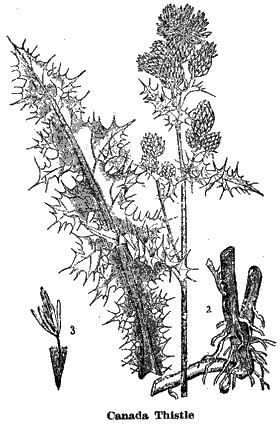
NEGenWeb
Project
Resource Center
Schools
|
|
237 |

leaves are about one and one-half inches long and heart-shaped. The tunnel or trumpet-shaped flowers are usually white, although some varieties produce pink or purplish flowers. The flowers appear throughout the summer, while the brown, rather large, pear-shaped, flat-sided seeds are ripe by August. Because of the numerous rootstocks and the abundance of seed produced, this weed spreads badly and is very hard to destroy. Any part of a root dragged by a cultivator, harrow, or plow to another part of the field will at once begin to grow. When the morning-glories are found in clover, alfalfa, or in other hay or pasture crops, it has been found practical to pasture to sheep or hogs. Many farmers let their spring lambs run in a cornfield Infested with morning-glories. They report that very little damage is done to the corn after August, but many morning-glories are destroyed. A short rotation of crops, the liberal use of the hoe with the broad-shared surface cultivator have proved very effective. When large areas are affected, smother crops are practical and will eradicate the pests after one or two years.
|
238 |
|
(Genus-Cuicus)
The Canada thistle is a perennial; grows to be about three or four feet high, and has very deep rootstocks; The leaves are irregular and deeply lobed with many spines on the veins and edges. The underside of Its leaves are covered with fuzz or down. The pinkish flowers appear in July and August. The seeds are light brown, about one-eight inch long, smooth, somewhat flattened and are often found in alfalfa and clover seed, chick feed, etc. The plant grows from both the seeds and the running rootstocks which send up shoots every few feet. When a plant is pulled up it usually breaks off a few inches below the surface of the ground. This does not kill the pest, as another bud along the rootstock starts to grow at once. Any of the methods used to destroy the perennials will be found effective.
(Genus-Chenopodium)
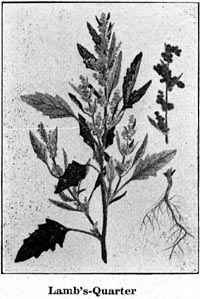
Lamb's quarter is an annual of such variable form that a definite description is very difficult. It is usually, however, a much branched plant with pale rough-edged leaves. It grows from two to six feet high. When small the plant is generally covered with small, mealy particles. The pale green flowers are borne on spikes at the attach-
|
|
239 |
ment of the leaf to the stem of the plant. The seeds appear from August to November and are shiny, black, round, fiat on one side, but convex on the other. These seeds are very common in commercial grass seed. As these plants are annuals, any method that will prevent the formation of seeds will eradicate them.
INSECTS
Definition:--A jointed animal, having six legs and breathing through tubes running through the body.
Classes:--For all practical purposes and from the standpoint of the farmer, all insects may be divided into two classes: sucking and biting. The method by which the insect secures its food determines its class. Sucking insects insert their tube-like mouths through the outer bark into the softer tissues and suck the sap, ruining the vitality of the plant and often causing its death. Chinch bugs, squash hugs and corn root aphis are insects of this class. The biting insects are those that have mouths provided with jaws and which chew and swallow their food. Armyworms, grasshoppers, cutworms, etc., are classed as biting insects.
Because of this division, different sprays and emulsions must be used to combat each class. The sucking insects can best be destroyed by having the poison come into direct contact with the body. This clogs the tubes through which they breathe and of course results in death. The biting insects are destroyed by poison placed on the plants eaten by them.
No one can successfully combat insects without knowing something of the life history and habits of the pests with which he has to deal. It is with this point in mind that this bulletin has been. prepared.
Grass is the natural home of the armyworm. The adult form of the armyworm is a brownish moth bearing a white spot In the center of each anterior wing. This moth usually lays its small, round, white eggs in the terminal leaf sheaths of small, grain, timothy and. other grasses. Eggs have been found in hay stacks. old cornstalks, and other unusual places. One female moth is estimated to lay in the neighborhood of six hundred eggs, which hatch in from eight to ten days. The larva feeds on any succulent food during its early life and when grown attains a length of about one and one-half inches. It has a broad stripe on each side, longitudinal stripes on its back, is dark in color and has very few hairs.
The larva pupates in rubbish and waste places. This stage lasts about two weeks. There are, as a rule, two to three broods in one season. The last brood hibernates either as a pupa, larva or moth.
|
240 |
|
One type of armyworm, known as the fall armyworm, differs from the true armyworm inasmuch as it is slightly more hairy, having large and more prominent black tubercles, and by a white inverted "V" on its forehead. The fall armyworm is especially injurious in the alfalfa fields of the west.
Certain diseases attack the larva, and insect parasites destroy a great many, yet it is found necessary to combat the pest in other ways. When the worms march in great armies from field to field it has been found very effective to plow a deep furrow in front of them. Holes should be dug in the furrows every ten or fifteen feet. As the worms fall into the holes, they can be crushed or killed with kerosene. In smooth pasture land and short meadows the worms can be killed with a heavy roller.
The chinch bug is a small black bug about one-fourth of an inch long, with white and black wings which when folded make a white cross on the back. The chinch bug is a sucking insect and gets its food by inserting its beak into the plant. When first hatched it is red in color and quite small. Chinch bugs have a very offensive odor.
The parent bugs live over the winter under old rubbish, along fence lines and in other waste places. The mother bug comes out when warm spring days appear and lays eggs in the wheat and other grain fields. The eggs begin to hatch in May and continue until late In the summer. The eggs for later broods are usually laid at the base of weeds in the cornfield.
Chinch bugs are more numerous and do much more damage in dry seasons than in wet; They have caused thousands of dollars of damage to crops in this state. They may increase in number for three or four years, and then almost entirely disappear. There is a white fungus called the chinch bug fungus, the growth of which is favored by wet seasons. This fungus grows on the body of the chinch bug and kills it.
The fence lines around the fields should be kept free from all trash and rubbish, and the weeds should be mowed and burned. Chinch bugs rarely ever do serious damage to the oat crop. But in seasons favorable to them they do serious damage to wheat, rye, barley, and forage crops. When the wheat is cut about the 4th of July, they may pass from this field into the cornfield. When they appear in such numbers, it is advisable to plow a strip ten to fifteen feet wide between the infested field and the cornfield. Plow a furrow through this broken strip, making the sides as vertical as possible. Pulverize a narrow strip on each side of the furrows, dig holes two feet deep in the bottom of this furrow, about ten to fifteen feet apart. The insects upon reaching the ditch will tumble in and are unable to climb up the steep sides. They can then be killed by dragging a log up and down the furrow with a horse. Those which fall into the deeper holes can be
|
|
241 |
destroyed with coal-oil. Some farmers place a tar line between the affected fields and the first trench. This will prove very effective.
The cutworms vary in color from light brown to dark brown. They have a smooth skin and often stripes running the long way of their bodies. Cutworms injure the plant by eating off the leaves and often cut the plant off close to the ground. They work at night and spend the day time curled up under clods, or bury themselves just beneath the surface of the ground.
The eggs from which these worms are hatched are laid in grass lands late in the season by grayish-brown moths. These eggs hatch the same fall and the young larvae live on the roots of grass until severe weather sets in. They then bury themselves in the ground until the next spring. The number of broods varies from one to three, depending on the species. In most cases the larva has reached its maturity by the first of July, after which it pupates. The moth appears toward the latter part of the season. It is always advisable to plant a field affected with cutworms late in the season, as they are most injurious the year following sod. Early plowing is one of the best methods of preventing it from destroying the crop. Poisoning has also proved effective. When a field is located along the side of a meadow, it has been found effective to poison fresh clover with a solution of one pound of Paris green to fifty gallons of water and sprinkle along the border rows. It is also beneficial to mix one pound of Paris green with thirty pounds of bran and apply to the field with a drill.
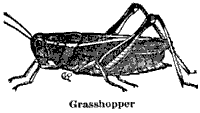
There are many forms of grasshoppers, but the same methods of destruction apply to practically all. Grasshoppers are so generally known that it is not necessary to give a description of them in this bulletin
In the fall the female lays her eggs in bunches or pods in the ground. These pods contain from twenty to fifty eggs and are usually buried about one inch deep. The eggs are usually deposited along fence rows, ditches, waste corners, meadows, etc. The hoppers are hatched the following spring. At first the damage of the nymphs, as the young hoppers are called, is not very noticeable but after they grow older their presence is often disastrous to certain growing crops.
|
242 |
|
Late fall plowing and deep disking has been found very effective in destroying these pests. Either implement disturbs the egg pods by breaking, burying, and turning them to the surface where they can be destroyed by the sun, birds, and other natural enemies.
The jumping kind of grasshoppers can be destroyed by mixing one pound of Paris green with twenty pounds of bran together with enough water to thoroughly moisten the mixture. This mixture can be made into balls and scattered along the edge of the field where the hoppers are doing the injury. The only objection to this mixture is that birds and poultry are likely to eat it and be killed. This can be largely avoided by using fresh horse manure instead of bran.
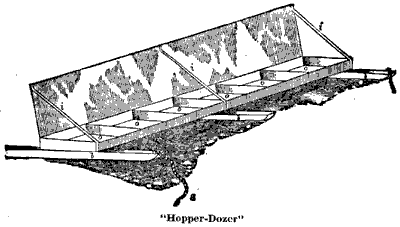
Where the ground is level, a hopper dozer can be used to good advantage. This machine can be easily and cheaply made. It consists only of a long sheet iron pan fastened to two runners and having a strong piece of cloth fastened to the back of the pan to an upright frame. Place water in the pan and add enough coal-oil to form a thin film over the surface. Hitch a horse to one of the outside runners and bring a rope from the other outside runner to the hame-staple of the harness. As the hopper dozer is dragged through the field many of the grasshoppers fly against the apron and drop into the solution. The hopper dozer has proved most successful on alfalfa and clover fields.
Certain fungus diseases have proved effective in some localities.
The life cycle of white grubs is very interesting. The eggs which produce them are laid by the female "June Bugs" or "May Beetles." These beetles are thick-bodied and brown in color. They are often seen flying about electric lights, lamps, etc., at night. The beetles live but
|
|
243 |
a short time. The females usually lay their eggs during June. The eggs are generally deposited two inches in the ground and hatch In from ten days to three weeks. The young grubs eat roots of grass the first season. They hibernate as a larva and appear in the same form the next spring. In June or July of the second year they pupate and during August they appear in the adult stage. The adult usually does not leave its birthplace until the next spring, when it comes forth in the form of a "June Bug."
When corn is attacked by white grubs It turns yellow and the roots are very short and frayed at the end. If the grub is not found at the root of a plant that appears to be affected, it may often be located by digging in the earth a foot or two on each side.
Owing to the fact that the life-history of the white grubs extends over nearly three years and that they damage so many different kinds of plants, it has been found difficult to entirely destroy the pest. Fall plowing is one of the most effective methods of destruction. It is also advisable to turn hogs on fall plowed soil. The first crop of corn should be kept as clean as possible; this will prevent the beetles from depositing eggs in the field. As clover is seldom attacked by the white grub, one or two years of clover will materially aid in its destruction.
Wireworms are usually of a reddish-brown color, and vary from three fourths of an inch to one inch and a half in length. The body, which is almost bare, is very slender and about the same width throughout. The surface of the wireworm is hard. The body is composed of thirteen segments or sections. The six pairs of short legs are fastened on the three segments just back of the head. A single leg which somewhat resembles a sucker is located on the thirteenth segment. The click-bettles (sic), so called because of the snapping noise they make when laid on their backs, lay the eggs that produce the wireworms in the earth. These eggs are usually laid in meadows, pastures, or other grass lands.
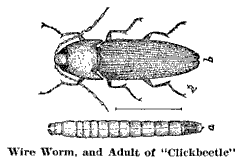
In the spring the wire worm comes forth from the ground and
 |
 |
 |
 |
|
© 2003 for the NEGenWeb Project by Ted & Carole Miller |
|||